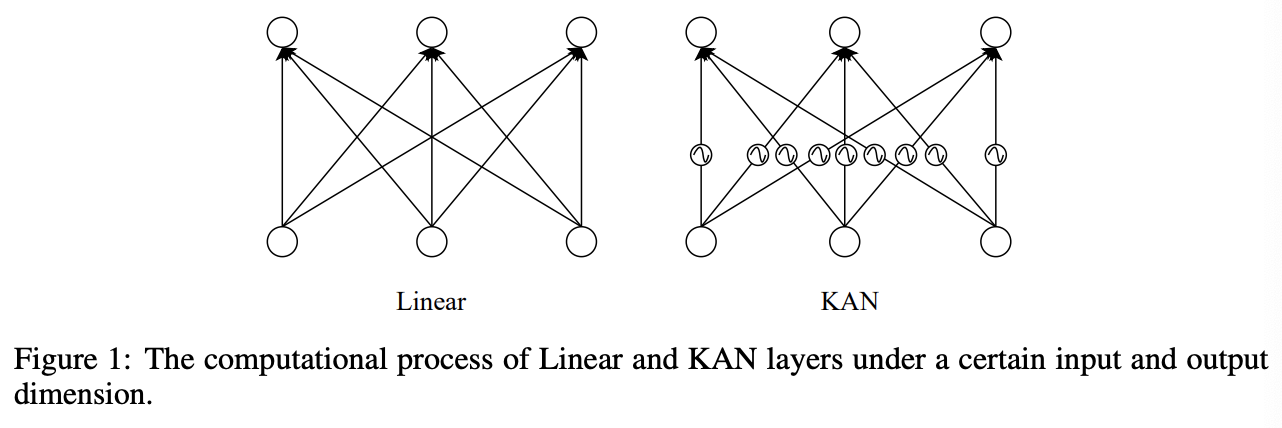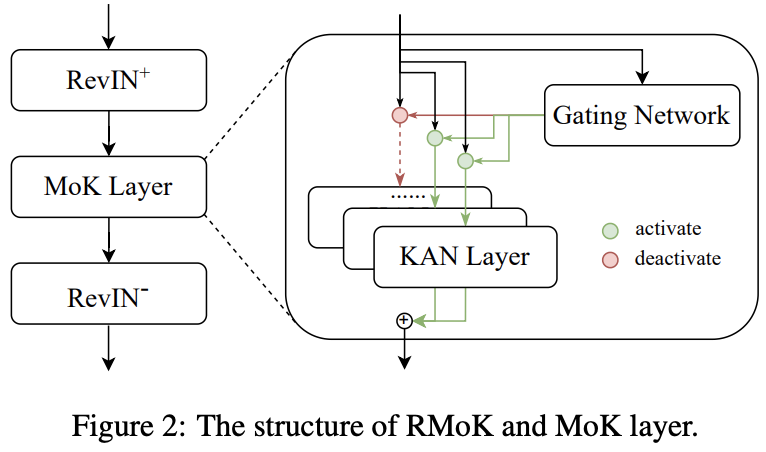KAN4TSF: Are KAN and KAN-based models Effective for Time Series Forecasting?
Contents
- Abstract
- Introduction
-
Problem Definition
-
KAN
- RMoK
0. Abstract
Existing methods in TS: 2 challenges
- (1) Mathematical theory of mainstream DL-based methods does not establish a clear relation between network sizes and fitting capabilities
- (2) Lack interpretability
KAN in TS forecasting
Better (1) mathematical properties and (2) interpretability
Propose Reversible Mixture of KAN experts (RMoK)
= Uses a mixture-of-experts structure to assign variables to KAN experts.
https://github.com/2448845600/KAN4TSF.
1. Introduction
Universal approximation theorem (UAT)
- Cannot provide a guarantee on the necessary network sizes (depths and widths) to approximate a predetermined continuous function with specific accuracy
Kolmogorov-Arnold Network (KAN)
-
Based on the Kolmogorov-Arnold representation theorem (KART)
-
(1) Proves that a multivariate continuous function can be represented as a combination of finite univariate continuous functions
-
Establishes the relationship between
-
a) network size
-
b) input shape
under the premise of representation
-
-
-
(2) Offers a pruning strategy
-
Simplifies the trained KAN into a set of symbolic functions
-
Enables the analysis of specific modules’ mechanisms
\(\rightarrow\) Enhance the network’s interpretability
-
-
KAN’s function fitting idea
= Consistent with the properties of TS (i.e., periodicity, trend)
(1) KAN
= Employs a trainable 1D B-spline functions
- to convert incoming signals
(2) KAN’s variants:
= Replace the B-splines with
- Chebyshev polynomials
- wavelet functions
- Jacobi polynomials
- ReLU functions
to accelerate training speed and improve performance.
(3) Other studies:
= Introduce KAN with existing popular network structures for various applications.
- ConvKAN
- GraphKAN
Existing studies lack a KAN-based model that considers TS domain knowledge!!
Proposal: RMoK
KAN-based model for the TS forecasting
Evaluate its effectiveness from 4 perspectives
- (1) Performance
- (2) Integration
- (3) Speed
- (4) Interpretability.
Reversible Mixture of KAN Experts model (RMoK)
-
Multiple KAN variants
- Use as experts
-
Gating network
- Adaptively assign variables to specific experts
-
Implemented as a single-layer network
( \(\because\) Hope that it can have similar performance and better interpretability than existing methods )
2. Problem Definition
-
Input: \(\mathcal{X}=\left[X_1, \cdots, X_T\right] \in \mathbb{R}^{T \times C}\),
-
Ouptut: \(\mathcal{Y}=\left[X_{T+1}, \cdots, X_{T+P}\right] \in \mathbb{R}^{P \times C}\)
3. KAN
Kolmogorov-Arnold representation theorem (KART)
-
Mathematical foundation of the KAN
-
Makes KAN more fitting and interpretable than MLP
( MLP: based on the universal approximation theorem )
Dfference between KAN and MLP

\(\mathrm{KAN}(\mathbf{x})=\left(\mathbf{\Phi}_L \circ \mathbf{\Phi}_{L-1} \circ \cdots \circ \mathbf{\Phi}_2 \circ \mathbf{\Phi}_1\right) \mathbf{x}\).
-
Input tensor \(\mathbf{x} \in \mathbb{R}^{n_0}\) & Structure of \(L\) layers
- \(\boldsymbol{\Phi}_l, l \in[1,2, \cdots, L]\): KAN layer
- Output dimension of each KAN layer: \(\left[n_1, n_2, \cdots, n_L\right]\).
Transform process of \(j\)-th feature in \(l\)-th layer
- \[\mathbf{x}_{l, j}=\sum_{i=1}^{n_{l-1}} \phi_{l-1, j, i}\left(\mathbf{x}_{l-1, i}\right), \quad j=1, \cdots, n_l\]
-
\(\phi\) consists two parts:
\(\phi(x)=w_b \operatorname{SiLU}(x)+w_s \operatorname{Spline}(x)\).
- (1) Spline function
- \(\operatorname{Spline}(\cdot)\): linear combination of B-spline functions
- \(\operatorname{Spline}(x)=\sum_i c_i B_i(x)\).
- (2) Residual activation function
- with learnable parameters \(w_b, w_s\)
- (1) Spline function
4. RMoK
(1) Mixture of KAN Experts Layer
Mixture of KAN experts (MoK) layer
- KAN + Mixture of experts (MoE)
- Uses a gating network to assign KAN layers to variables according to temporal features
KAN & KAN variants
-
Only differ in the spline function
\(\phi(x)=w_b \operatorname{SiLU}(x)+w_s \operatorname{Spline}(x)\).
This paper
-
Use \(\mathcal{K}(\cdot)\) to represent these methods uniformly
-
MoK layer with \(N\) experts:
\(\mathbf{x}_{l+1}=\sum_{i=1}^N \mathcal{G}\left(\mathbf{x}_l\right)_i \mathcal{K}_i\left(\mathbf{x}_l\right)\).
- where \(\mathcal{G}(\cdot)\) is a gating network
-
Adapt to the diversity of TS
- Each expert learning different parts of temporal features
Gating network
-
Key module of the MoK layer
-
Responsible for learning the weight of each expert from the input data.
-
Softmax gating network \(\mathcal{G}_{\text {softmax }}\)
- Uses a softmax function & learnable weight matrix \(\mathbf{w}_g\)
- \(\mathcal{G}_{\text {softmax }}(\mathbf{x})=\operatorname{Softmax}\left(\mathbf{x w}_g\right)\).
-
However, it activates all experts once
\(\rightarrow\) Resulting in low efficiency ( when there are a large number of experts )
\(\rightarrow\) Adopt the sparse gating network
Sparse gating network
\(\begin{gathered} \mathcal{G}_{\text {sparse }}(\mathbf{x})=\operatorname{Softmax}(\operatorname{KeepTopK}(H(\mathbf{x}), k)) \\ H(\mathbf{x})=\mathbf{x w}_g+\operatorname{Norm}\left(\operatorname{Softplus}\left(\mathbf{x w}_{\text {noise }}\right)\right) \end{gathered}\).
- Only activates the best matching top- \(k\) experts.
- Adds Gaussian noise to input time series by \(\mathbf{w}_{\text {noise }}\) & KeepTopK operation to retains experts with the highest \(k\) values.
(2) Reversible Mixture of KAN Experts Model
Sophisticated KAN-based model
=> By stacking multiple KANs
( or replacing the linear layers of the existing models with KANs. )
Design a simple KAN-based model
- Easy to analyze
- Achieve comparable performance to the most SOTA TS models
Propose a simple, effective and interpretable KAN-based model,
Reversible Mixture of KAN Experts Network (RMoK)

[Training stage]
-
Gating network has a tendency to reach a winner-take-all state
= Gives large weights for the same few experts
-
( Following the previous work ) Load balancing loss function
- Encourage experts have equal importance
Load balancing loss function
- Step 1) Count the weight of experts as loads,
- Step 2) Calcuate the square of the coefficient of variation
- \(\mathrm{L}_{\text {load-balancing }}=\mathrm{CV}(\text { loads })^2\).
Total loss function
- \(\mathrm{L}=\operatorname{MSE}(\mathcal{Y}, \hat{\mathcal{Y}})+w_l \cdot \mathrm{~L}_{\text {load-balancing }}\).
